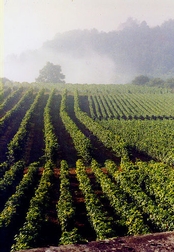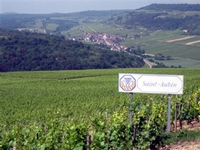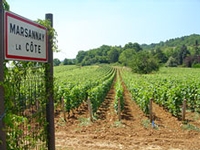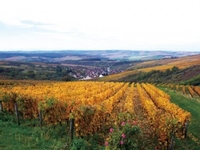What comes to mind when you hear someone mention Burgundy wines? Most serious wine drinkers automatically think Côte d’Or Pinot Noir and Chardonnay. And that makes sense because, despite the high prices, red Burgundy from the Côte d’Nuits and white Burgundy from the Côte de Beaune are the most popular Burgundy with American wine drinkers, and they are the wines sought after by collectors.
However, there is another Burgundy–or perhaps multiple other Burgundies. Beyond the Côte d’Or are other appellations producing wines from the same grapes, but without the public image and lofty prices of Côte d’Or wines. Separate from the Côte d’Or, is the Auxerre appellation, home of the crisp whites of Chablis and the lesser known red wines of Irancy. At the northern end of the Côte de Nuits, Marsannay forms a small unique enclave producing white, pink and red wine. In southwestern Côte de Beaune is Saint-Aubin, a west-leaning outcropping known mainly for white wines. South of the Côte de Beaune lies Givry, a mostly red wine zone tucked within the sprawling Côte Chalonnaise. Further south still, just before crossing over into Beaujolais is the Maconnais, famous for value white wines, including those of St. Veran.
Burgundies. Beyond the Côte d’Or are other appellations producing wines from the same grapes, but without the public image and lofty prices of Côte d’Or wines. Separate from the Côte d’Or, is the Auxerre appellation, home of the crisp whites of Chablis and the lesser known red wines of Irancy. At the northern end of the Côte de Nuits, Marsannay forms a small unique enclave producing white, pink and red wine. In southwestern Côte de Beaune is Saint-Aubin, a west-leaning outcropping known mainly for white wines. South of the Côte de Beaune lies Givry, a mostly red wine zone tucked within the sprawling Côte Chalonnaise. Further south still, just before crossing over into Beaujolais is the Maconnais, famous for value white wines, including those of St. Veran.
Last December I had the good fortunate to spend a week traveling and tasting in these lesser known Burgundy appellations. I had been to the Côte d’Or before, but had not visited the other regions, so I packed my bag and headed for Burgundy before the weather turned cold and blustery. What I found were friendly, enthusiastic winemakers and vintners, eager to tell their stories and for the wine world to learn about their wines.
Although I had some previous knowledge and experience with the wines of St. Veran, Saint-Aubin, Givry and Marsannay, I was in for a surprise in Irancy, where they make red wine from Pinot Noir and an obscure local grape called Cesar. By a geological and climactic happenstance, these five regions fall outside the boundaries of the better known Burgundy regions producing white and red wines from the same grapes, usually on similar, if not the same soils. Nevertheless, the absolutes of the current French AOC system (the term AOC will be dropped at the end of 2010 to be replaced by the EU designation AOP or Appellation d’Origin Protogee) is the reality that all Burgundy winemakers must live by. The people I met, mostly young second and third generation, are proud of their appellations, regional differences and wines and they continue to look for new ways to improve their wines while still observing the rules.
To give proper due to all five of the Burgundy appellations visited, I’ve divided them into two columns. In March, part 2 of “The Other Burgundy” will explore the wines of the southern appellations of Givry and St. Veran. This month, the focus is on Saint-Aubin and Marsannay, with a few words on Irancy.
Saint-Aubin
South of the city of Beaune, the main road passes through Meursault, then Puligny-Montrachet and at the intersection with the N6, just before  entering Chassagne-Montrachet, the route turns onto the national road and heads toward the hills, passing into a narrow valley and the small hamlet of Gamay, with the village of Saint-Aubin a few miles further on. At one time, Saint-Aubin was mostly red wine, but today two-thirds of the vineyards are planted to Chardonnay, with the other third to Pinot Noit. Fact is, the popularity of the wines of nearby Puligny-Montrachet and Chassagne-Montrachet prompted the 100 producers of Saint-Aubin to switch their focus from red wine to white.
entering Chassagne-Montrachet, the route turns onto the national road and heads toward the hills, passing into a narrow valley and the small hamlet of Gamay, with the village of Saint-Aubin a few miles further on. At one time, Saint-Aubin was mostly red wine, but today two-thirds of the vineyards are planted to Chardonnay, with the other third to Pinot Noit. Fact is, the popularity of the wines of nearby Puligny-Montrachet and Chassagne-Montrachet prompted the 100 producers of Saint-Aubin to switch their focus from red wine to white.
Jurassic clay-limestone soils form the base of the 350 acres of vineyards that run along the slopes of the small, hook-shaped valley, with many of the region’s premier crus at the business end of the hook. The vineyards are divided into three sectors; the first comprising the 20 premier crus, including the charmingly named “Derriere la Tour,” rising behind the lovely 10th century Romanesque church, itself positioned amidst the tight maze of narrow streets in the small village of Saint-Aubin. Another premier cru vineyard name that, on the surface is amusing, but when translated and explained makes sense is “Les Murgers des dents de Chien,” or the “wall of the dog teeth.” No dog teeth in the mortar-less low wall around this vineyard, but the irregular stones do resemble a set of long, sharp teeth.
According to a number of winemakers I spoke with in Saint-Aubin, the southeast exposure and gentle slopes with limestone-rich soils of such premier crus like Les Murgers and the neighboring En Remilly, is key to the crisp mineral character of Saint-Aubin Chardonnays, priced at an average of $30. Flavor, character and moderate price make Saint-Aubin whites more appealing in a weak economy than neighboring Puligny or Chassagne white wines. Still, to the geologically-challenged it remains a mystery why Chardonnay from Les Murgers or En Remilly costs so much less than a Chardonnay from Puligny-Montrachet vineyard, just across the dirt road.
The second sector, between the village of Saint-Aubin and the hamlet of Gamay is planted mainly to Pinot Noir, while the third sector west of the village is mostly for village appellation wines. As an indication of how quickly changing demand influences vineyards plantings, I was told that just 30 years ago Saint-Aubin was growing a fair amount of Aligote.
While Chardonnay shines in Saint-Aubin, Pinot Noir is no slouch, with the village wines boasting bright red cherry and spice notes supported by lively acidity and an underlying supple richness that is not unlike what one would find in a Chassagne-Montrachet rouge. Saint-Aubin’s red premier crus are richer with more depth and a lovely smoky mocha character. Producers of both white and red Saint-Aubin that I found particularly impressive include Domaine Marc Colin et Fils, Jean-Claude Bachelet et Fils, Roux Pere et Fils, Lamy-Pillot, Domaine La Rue, Patrick Miolane and Gilles Bouton.
Marsannay
Prior to 1987, if you had bought a bottle of wine from Marsannay it would have been labeled simply as “Bourgogne.” Today, the red, white and rosé wines from this small sub-region in the northernmost appellation of the Côte de Nuits are proudly called “Marsannay-La-Côte” or, more popularly, simply “Marsannay.” Unlike the neighboring commune of Gevrey-Chambertin, Marsannay has no premier cru vineyards, but it does have very good white and red wine and a charming pink wine. Samples of the white wines I tasted last December in Marsannay were uniformly fresh, mineral and with good depth of flavor and moderate alcohol and oak. Before my visit, I read some less-than-glowing comments about Marsannay blanc; however, I was more impressed with some of the whites I tasted than the reds–which is an uneasy admission for this Pinot Noir fan.
appellation of the Côte de Nuits are proudly called “Marsannay-La-Côte” or, more popularly, simply “Marsannay.” Unlike the neighboring commune of Gevrey-Chambertin, Marsannay has no premier cru vineyards, but it does have very good white and red wine and a charming pink wine. Samples of the white wines I tasted last December in Marsannay were uniformly fresh, mineral and with good depth of flavor and moderate alcohol and oak. Before my visit, I read some less-than-glowing comments about Marsannay blanc; however, I was more impressed with some of the whites I tasted than the reds–which is an uneasy admission for this Pinot Noir fan.
Marsannay vineyards, rising on gentle slopes to approximately 1,500 feet are sandwiched between Fixin in the south and the outskirts of the city of Dijon in the northeast, mostly on the west side of the N74 highway that passes by Marsannay from Gevrey-Chambertin to Dijon. Exposures are mostly due east and the diverse soils are mainly Jurassic strata. Of the 1,358 acres planted, more than half are in Chardonnay with the remainder planted to Pinot Noir.
Being situated within the Côte de Nuits might be intimidating to some, but not the group of young dynamic Marsannay winemakers, like Cyril Audoin and Guillaume Sylvain whom I met. Audoin, the third generation to run the family winery and estate, took over from his father in 2001 and proudly says that in 1976, his mother became one of the first female enologists in France. Like many winemakers of his generation, Audoin gained experience and knowledge about other wines, working in California before returning to Marsannay. His wines have texture, fresh fruit, unobtrusive oak and moderate alcohol. Quiet and reflective, Audoin is the polar opposite of Guillaume Sylvain, an energetic redhead with a non-stop patter about Marsannay wines and wine in general. Unlike most of his peers, Sylvain is self-trained and, through sheer persistence, managed to open a small cluttered winery in 2004. Recommended Marsanny wines include Domaine Charles Audoin, Domaine Bruno Clair, Derey Freres, Sylvain-Pataille, Rene Bouvier, Domaine Regis Bouvier and Domaine Jean Fournier.
Irancy
Of the five Burgundy sub-regions I visited, Irancy offered the most unusual wine. Located south of the cathedral city of Auxerre and next  to Chablis, Irancy is a relatively unknown island of a two-variety blended red wine amidst a world-famous white wine. Like all other red wines produced along the Côte d’Or and the surrounding smaller appellations, Irancy is made primarily from Pinot Noir, with small amounts of Cesar, an obscure red variety that grows only in Irancy.
to Chablis, Irancy is a relatively unknown island of a two-variety blended red wine amidst a world-famous white wine. Like all other red wines produced along the Côte d’Or and the surrounding smaller appellations, Irancy is made primarily from Pinot Noir, with small amounts of Cesar, an obscure red variety that grows only in Irancy.
The small village of Irancy is tucked into a lovely pocket valley, with more than 400 acres of Pinot Noir and less than 3% of Cesar climbing the slopes on three sides of the amphitheater-like valley. Cesar, also known as Roman or Romain, is a grape of antiquity, believed to have been introduced to the region by the Roman legions in the second century A.D. The Irancy producers I spoke with are divided about the use of Cesar, although most of them believe that the continued use of the rustic grape is retained more out of tradition than preference and that Cesar should not make up more than 10% of the final blend.
Irancy reds have fruity, sometimes grapy, aromatics, but lack the same fruitiness on the palate. In younger Irancy reds wines blended with Cesar, the Pinot Noir component fights with the hard, drying tannins of Cesar, an unnervingly astringent experience not normally found in Pinot Noir wines. Older Irancy wines I tasted, especially with food at the delightful Bar Restaurant Le Soufflot, on the village main street, tend to show less of the hard tannins. While unique and worth a try, the Irancy wines blended with Cesar seem to be out of step with the brighter, fruitier Pinot Noirs (with supporting but not obtrusive tannins) seen in today’s international market. Irancy wines I liked, though available in limited U.S. markets, include those of Domaine Colinot and Thierry Richoux.
A number of the domaines, whose wines I tasted in Saint-Aubin, Marsannay and Irancy do not export to the United States. Mostly, they are small family-owned wine estates with limited production and what small amounts they do export are going to traditional export markets like the United Kingdom. Next month, I’ll focus on Givry and St. Veran, two enclaves within the southern Côte Chalonnaise and the Maconnais, respectively.
